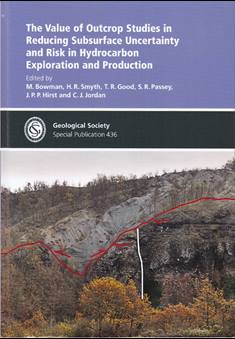The Value of Outcrop Studies in Reducing Subsurface Uncertainty and Risk in Hydrocarbon Exploration and Production
 This volume is a collection of papers presented at a 2014 Geological Society of London conference. The objective is to reflect major advances in the analysis and integration of outcrop data as analogues for the subsurface, and the text does an excellent job of providing considerations and case studies.
This volume is a collection of papers presented at a 2014 Geological Society of London conference. The objective is to reflect major advances in the analysis and integration of outcrop data as analogues for the subsurface, and the text does an excellent job of providing considerations and case studies.
The first paper addresses environmental health and safety fieldwork considerations. It initially appears out of place, yet contains a plethora of useful mandatory information to maximize safety during fieldwork. Adherence to its precepts could save someone’s life.
Four papers address basin-scale projects: One for an onshore-to-offshore model in NW India; another for intravolcanic analogues on the Faroe Islands; a third for injecitite sandstones in the North Sea; and a final paper focused on complex sequence stratigraphy in Apennine foreland basins.
Reservoir-scale examples constrained using outcrop data are also considered. One paper discusses thin discontinuous facies of an Algerian gas reservoir, a second focuses on sequence analogues in offshore Trinidad, and a third examines Eagle Ford Shale outcrop analogues. The latter study is particularly interesting because it cleverly integrates outcrop-sourced gamma ray and geochemical data in a new regional sequence stratigraphic compilation.
Fieldwork techniques are discussed in a study outlining the critical differences between structural and sedimentological analogues. Structural analogues fall into two categories: 1) the direct use of structural analogues to compare field examples to the subsurface; and 2) the use of topology to study fault and fracture networks, and thereby understand the age and connectivity of structures, spatial variability, and structural scale.
The section on fieldwork techniques also includes a historical evolution of the British Geological Survey mapping programmes, most notably digital mapping and data collection via unmanned aerial vehicles, as well as discussion of the use of laser-scanned outcrop data to create static-flow CO2 simulation models.
The final paper challenges the value of uncertainty characterization and our assumption that new data improves prospect risk. The authors argue instead that new information adds primary value in eliminating prospects and identifying new areas to examine.
Many of the regional cross-sections and stratigraphic sections are difficult to see due to extremely small text size. Putting an entire basin cross-section or well log in a half-page graphic renders them nearly useless. It would be helpful to provide digital copies of these graphics.
Despite these limitations, the volume contains many interesting papers that should be useful to anyone working a basin that requires the use of outcrop analogues to characterize limited and challenging subsurface geology.
Reviewed by Thomas Hoak
THE VALUE OF OUTCROP STUDIES IN REDUCING SUBSURFACE UNCERTAINTY AND RISK IN HYDROCARBON EXPLORATION AND PRODUCTION. Edited by M. BOWMAN, H.R. SMYTH, T.R. GOOD, S.R. PASSEY, J.P.P. HIRST & C.J. JORDAN. Geological Society of London Special Publication No 436, 2016. ISBN 978-1-78620-309-0. 268pp. hbk. List price: £ 90.00. Fellow's price: £ 45.00. W: https://www.geolsoc.org.uk/SP436